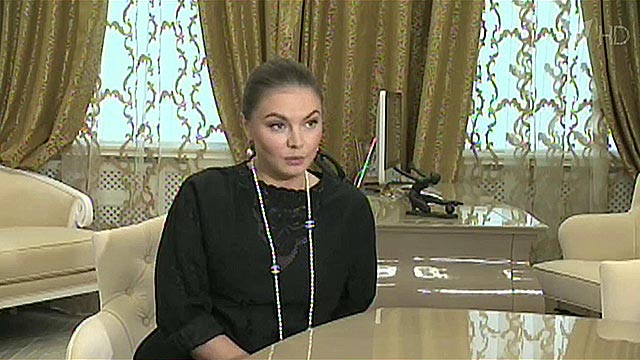Updated Daily. This week’s issue:
–5 Policeman Killed Detaining Suicide Bomber in Grozny; Terrorist Identified
Russian Ultranationalist Web Site Owner Summoned to Police in ‘Extremism’ Investigation
– Despite Further Refutations Even From Separatist Leaders, Mass Graves, ‘Organ-Trafficking’ Disinformation Still Circulates
– OSCE Representative on Human Trafficking Purveys Russian Propaganda Story of ‘Organ-Trafficking’ in Ukraine
– Veteran Russian Human Rights Group to Curtail Operations
– Putin’s Girlfriend to Head Russian Media Group
Russian State Media Continues to Distort News of Mass Graves in Ukraine
– RT Plagiarizes Breitbart Story On Obama’s Intelligence Briefings
– Russian Ruble Hits All-Time Low
– The Mystery Surrounding the Death of Russian Journalist Andrei Stenin
– Pro-Government Russian Groups Rally at War Memorial to Denounce Ukrainian ‘Fascists’
– Russia Accuses Ukraine of Atrocities; Media Distorts OSCE Report
– Ruble Falls To Record Low After Prosecutors Confirm Lawsuit to Nationalize Bashneft
– What is Yevtushenkov’s Relationship to Support for Russian-Backed Separatists in Ukraine?
– Prosecutor Demands Return of Bashneft Shares to State; Yevtushenkov To Remain Under House Arrest
– Russians Polled Find Putin ‘Most Moral’ Figure; But Some Find Navalny, Khakamada, Sakharov
– Russian Environmentalist Vitishko Loses Appeal of Prison Term
– How Many Russian Soldiers Have Been Killed, Wounded or Captured in Ukraine?
Please help The Interpreter to continue providing this valuable information service by making a donation towards our costsâ€.
Five Chechen policemen were killed in Grozny as they stopped a suspicious man at a metal-detector who then blew himself up, RIA Novosti and other Russian media reported. Another 12 persons were reportedly wounded in the blast.
Grozny, the capital of the Chechen Republic, was preparing to celebrate the 196th anniversary of the city as well as the 38th birthday of Chechen leader Ramzan Kadyrov, which fall on the same date.
The bomb went off at the intersection of Rosa Luxemburg Street and Isayev Avenue.
Kadyrov had just sent out a post on the city’s anniversary and on his own birthday on his favorite social media, Instagram, when the explosion occurred at 17:05 local time.

Kadyrov decided to continue the festivities and made his first reference to the bombing in an Instagram post within two hours of the blast. He said that the sacred month following Ramadan was a time when Muslims were forbidden to kill, so that the bomber had violated religious precepts. The Interpreter has translated an excerpt:
The Wahabbists and terrorists cursed by the Prophet (swt) tried to tern the holidays into a national tragedy, to shed the blood of dozens and hundreds of people.
This bastard bandit with a pistol introduced himself as a police officer and tried to pass through to the square where a whole number of festivities were being celebrated. The courage and professionalism of the police employees prevented numerous possible civilian victims. While he was being searched, the bastard set off the suicide bomb. A terrorist act which these satans wanted to comit on
the holidays, when the whole city was out celebrating and there were
festive events, wanted to ruin the mood, but that’s not happening,
people are continuing to celebrate.
Officers have been killed and wounded. They will be given state awards. The Wahabbists wanted to show that they exist, but we will prove that they shouldn’t be in Chechnya and nowhere else. We will destroye them, no matter where they are found. This incident did not affect the situation in Chechnya. It is stable and is completely controlled by the law-enforcement agencies.
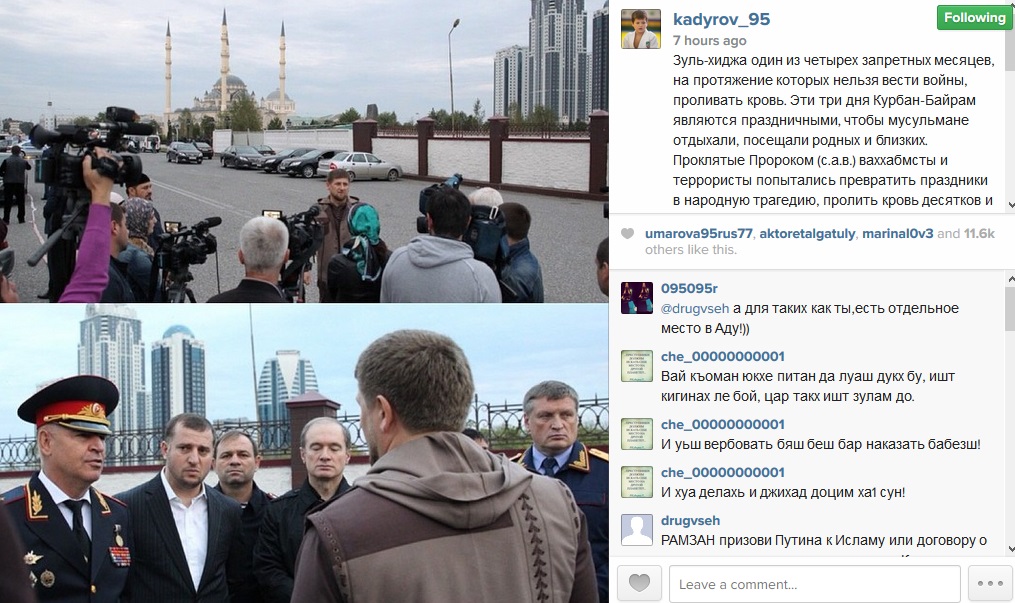
He then continued to tweet out several other pictures and lectures against terrorism and the need to raise youth properly.
In an Instagram post showing a balloon with his father’s picture, he attached a recorded message in which he said:
People wanted to ruin so to say our holiday. Thanks to our police
officers, the terrorist attack was prevented. I think in the near future
we will destroy the people who are behind this terrorist attack. People
are continuing to celebrate the city holiday, the teacher and youth
day.
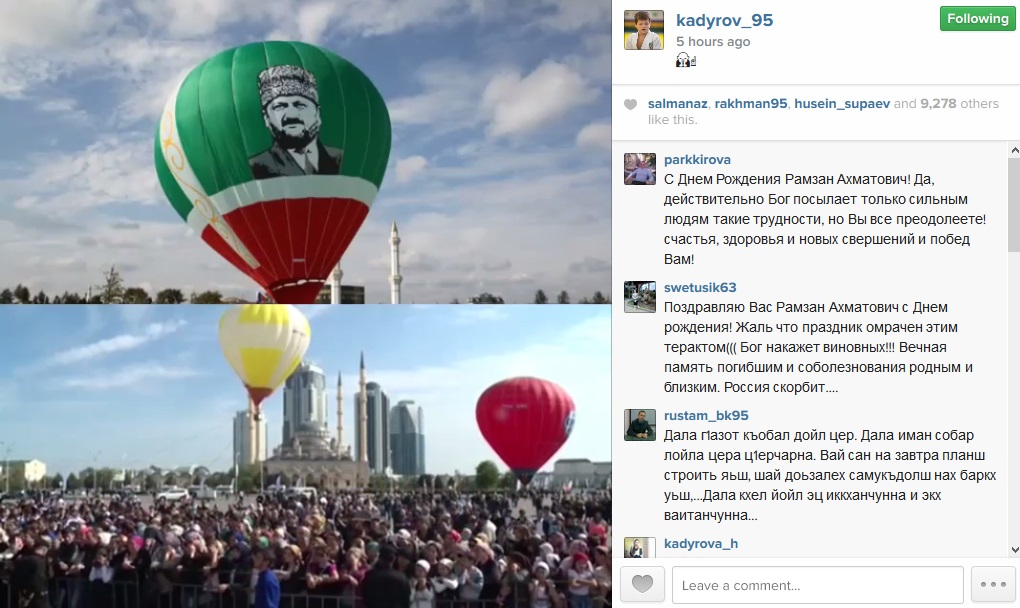
The suicide bomber was quickly identified as Apti Mudarov, age 19, from Staropromyslovsky District of Grozny, the Russian Investigative Committee told Komsomolskaya Pravda (KP).
The youth had been missing from his home for two months, said law-enforcement officials.
KP said that the bomber was wearing a suicide belt. But ridus.ru, an independent news service that tends to be pro-Russian, said that he was just carrying a bag of explosives, as did initial Russian state wire services.
The variation in the way the story has been covered by state and independent media relates to the question of whether the suicide bomber was intent on actually committing suicide as a true believer in radical Islamism, or whether he was actually hoping to pass as a police officer, and preparing to lay explosives but escape.
Although Kadyrov’s original statement on Instagram didn’t make any mention of a documents check, the first quotation of Kadyrov which we saw quoted from Interfax on ridus.ru, TV Rain at 19:20, and also on RIA Novosti at 18:57 introduced this detail and didn’t specify that it was a suicide bomb (translation by The Interpreter)
He came up to the post with a pistol, introduced himself as a
law-enforcement officer, but despite this, the police asked him to show
some documents and began examining him. While he was being searched, the
bomb went off. A terrorist act which these satans wanted to commit on
the holidays, when the whole city was out celebrating and there were
festive events, they wanted to ruin the mood, but that’s not happening,
people are continuing to celebrate.
The version TV Rain ran at 19:20 citing Interfax was slightly different:
This evening at a checkpoint for citizens to pass through to the festival for Grozny Day, olice officers stopped a young man. He had a pistol on him, he introduced himself as a police officer. At the request to submit to a search, the young man set off an explosive device.
At that time, Kadyrov said police were still looking for the terrorist.
Komsomolskaya Pravda then ran the story with this information:
At first there was information that the bandit had survived after the suicide-bombing. Although soon afterward, this information was refuted by law-enforcement officials of Chechnya.
Then KP used a different quote from Kadyrov, not from RIA Novosti, but the same one we translated above which starts, “The Wahabbists and terrorists cursed by the Prophet (swt) tried to tern the holidays into a national tragedy.”
Graphic pictures of the suicide bomber filled Twitter within hours, showing that his right arm and leg had been blown off, but the rest of his body was intact, supporting the thesis that he was not wearing a suicide belt. A Twitter user said he had been holding the bag of explosives in his right hand, and that there was no belt.
The area where the bombing took place is at the city center and is named for Kadyrov’s father, Akhmat, who was himself assassinated in a terrorist bombing in May 2004 during a World War II victory parade, in which his bodyguard and some 30 other people also were killed.

A graphic video of the dead bomber and policeman was uploaded to YouTube but removed under Google’s terms of service. Ridus.ru published some screenshots.
The pro-Kremlin REN-TV appears to have been first on the scene to capture the aftermath of the blast, tweeting a photo showing the dead policemen’s bodies by the metal detectors.
LifeNews also captured the blast and ran footage later showing numerous first-responders on the scene, noting that the policemen had prevented the suicide bomber from killing more people.
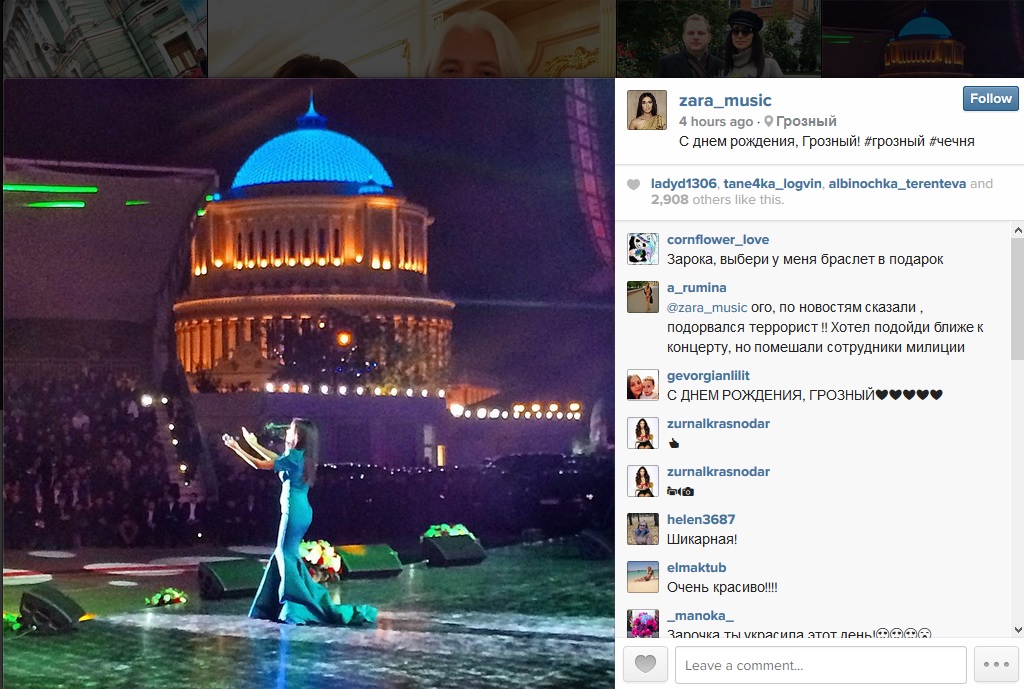
Kadyrov then released a longer statement on Instagram, an excerpt of which has been translated by The Interpreter:
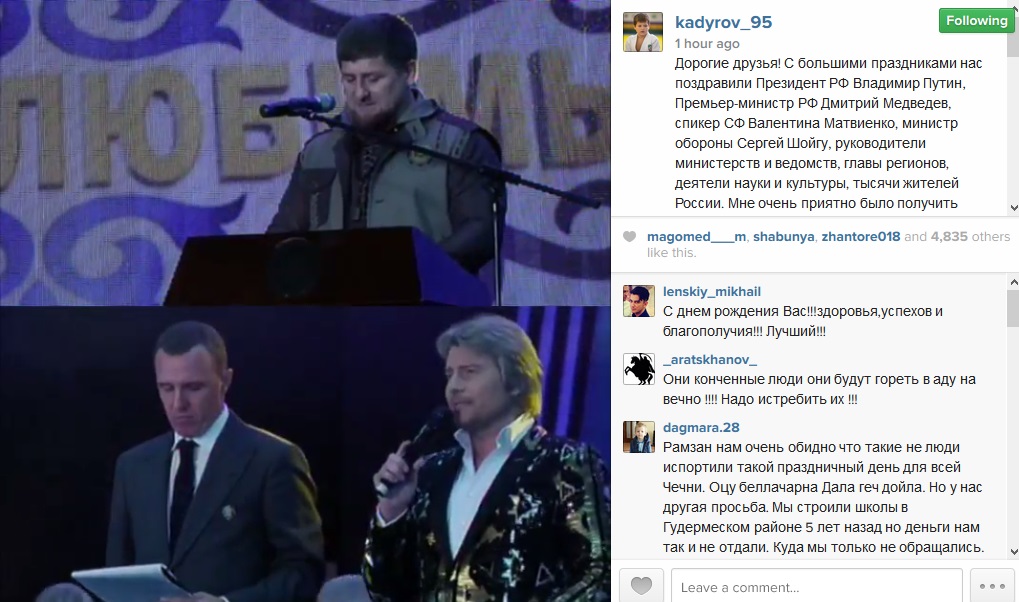
I am very grateful to all those who congratulated us, who is joyful for our successes and supports us in this difficult moment. At a time when tens of thousands of residents of Chechnya and our guests were marking the holidays of the city, youth and teachers, some sort of bastard bandit without a clan or tribe made an attempt to shed the blood of the participants of the festival.
Vigilant police officers detained him at the very first post not far from the public celebration area. At the price of their own lives, they prevented a terrorist act capable of taking away the lives of dozens of civilians. This abortion does not represent anyone. There is peace, stability and prosperity in the republic. We are looking confidently to the future. But the terrorists and Wahabbis only understand the language of force. They must be destroyed, wherever they stick up their heads. We will combat them in Chechnya and beyond its borders, because they do not have the right to live on this earth. They are damned by the Prophet (swt). And in the future there will be nothing of them here! And so that they never appear anywhere, we must raise youth in the norms of the Koran and the Sunni Prophet (swt), we can’t wait for the Udugovs, Zakayevs and Western intelligence agencies to befuddle their minds!
His last statement is a reference to Chechen resistance leaders Udugov, who has gone into hiding and Zakayev,
who lives abroad and also the unsubstantiated conspiracy theory that Western intelligence
clandestinely undermines Russia by supporting Chechen terrorists.
In a sign that the Russian government may be reining in some of the far-right groups they have tacitly encouraged throughout the war on Ukraine, the owner of the ultranationalist web site Sputnik & Pogrom has been summoned to the police for questioning in an investigation on “extremism” charges.
Yegor Prosvirnin writes on his web page that yesterday on 2 October he was called in for questioning under Art. 280-2 (“public calls for extremist activity committed with the help of mass media, including the Internet”).
Sputnik & Pogrom is a site popular with the younger generation of Russian extremists as it uses satirical writing and slick graphics to attract attention on social media. The name comes from the two words that the Russian language has given to foreign languages, ostensibly symbolizing the best and worse of Russian culture, although S&P have made no secret of their anti-migrant sentiment. Prosvirnin has been an avid fan of the Russian-backed separatists and has particularly popularized Col. Igor Strelkov.
Prosvirnin said he refused to answer questions, citing Art. 51 of the Russian Constitution which says that no one can be forced to incriminate themselves. Police then took his signature stating this refusal and informed him the case was being transferred to the Federal Security Service (FSB) or intelligence agency of Russia. He believes that a case is not yet open but that it is being contemplated.
Last week, Prosvirnin was called into the prosecutor’s office for questioning, and mention was made of “FSB evaluation,” but he says did not publicize the summons “so as not to give a motive for Ukrainian propagandists.”
Now that the case has gone further, he has decided to disclose it.
“Against one of the main propaganda sites of Novorossiya and the Russian Spring, the FSB is putting together a criminal case so as to punish people for helping the Russian insurgents,” writes Prosvirnin. Russians often use the term “propaganda” in a positive sense. Says Prosvirnin (translation by The Interpreter):
If a case is opened, regardless of the outcome, it will be the main argument for every supporter of Ukraine, a text-book example, of what help to Russians under a living Putin leads to, and also an absolutely murderous argument in any debates with nationalists (“Remember Prosvirnin? He collected 30 million for Novorossiya, yeah. Now he’s collecting money for cigarettes in Magadan.” )
Therefore I would entirely sincerely recommend bringing to account for extremism those who initiated this entire story. It should be noted that today our cite has nearly been taken down by Ukrainian hackers (they even managed to gloat on korrespondent.net) therefore your FSB is operating in a pleasant synchronicity with the “fascist junta in Kiev.“
Magadan is a remote city where a prison camp from the GULAG era is located.
Prosvirnin reassured his readers (some of whom are paid subscribers) that even if he is jailed the work will continue and indicated that even in prison colonies these days, people have mobile phones.
“Even if I have to sew mittens in Krasnokamensk, I will still call for the creation of a Greater Novorossiya and its return to Russia.” His reference is to a job frequently given to prison labor. Krasnokamensk is the city in the remote region of Chita where Mikhail Khodorkovsky served part of his term.
In June, Eurasianist ideologue and ultranationalist Aleksandr Dugin, a professor at Moscow State University, had a renewal of his contract revoked, evidently in connection with his incitement of hatred of Ukrainians.
The original Moscow leadership of the self-proclaimed “Donetsk People’s Republic” — Col. Igor Strelkov, Aleksandr Boroday, Denis Pushilin, and Vladimir Antyufeyev, have been replaced by Donbass-based figures.
It’s a rare day that the Russian-backed separatists are more truthful than the Moscow propaganda outlets that fuel their information warfare, but that’s the case in the affair of the false reports of “40” or even “400 bodies in mass graves” and “organ-trafficking” as we reported yesterday.
Separatist leaders themselves from the self-proclaimed “Donetsk People’s Republic” have discounted a report sourced with Einars Graudins, a Latvian activist who has made a number of unsubstantiated allegations about Ukrainian atrocities, Svoboda, the Russian-language service of the US-funded Radio Free Europe/Radio Liberty reports.
Andrei Purgin, the vice premier of the so-called “Donetsk People’s Republic” provided even more clarification yesterday to Interfax (translation by The Interpreter):
We were not understood correctly, and as a result the information was distorted. We were talking about the fact that 400 is the total number of unidentified bodies remaining in the Donetsk morgues. Ninety-percent of them are civilians who died at various times. Many of the bodies are disfigured and it is hard to make an identification. Therefore we appealed to Russian specialists with a request to conduct DNA analysis.
Earlier this week, Aleksandr Zakharchenko, the DPR’s prime minister, explained that he, too, was “misunderstood” when Russian state media claimed that there were “40” victims in mass graves; he said he was referring to other graves with combatants who were missing intestines because of shrapnel wounds.
The OSCE Special Monitoring Mission found 9 bodies in three grave sites outside of Donetsk in Nizhnyaya Krynka, and made no claims about their status as forensic examination is outside their mandate.
The false statements made by Graudins were readily picked up by REN TV, Channel 1 and other pro-government media and have spread across pro-Russian forums and pro-Kremlin Western web sites as well.
While they’ve been refuted by the separatist leaders themselves, the false report that there are “hundreds of bodies in mass graves” live on in Russian-language RIA-Novosti in a report today October 3 and have been cited even by Foreign Minister Sergei Lavrov, who should know better.
The “400” and the “organ-trafficking” stories have been flogged hard by a new English-language pro-Kremlin propaganda outlet called Russian Insider
Set your watches for when the fake “organs-trafficking” story will appear on infowars.com — as it did back in July — and Daily Kos, which routinely reprints Moscow disinformation.
The issue of the mass graves has also been raised by AP’s Matt Lee at the State Department noon press briefing, and received this reply from State Department spokesperson Jen Psaki:
Well, we are confident that the Ukrainian Government will continue to investigate these claims in conjunction with international experts, as they did when at least eight bodies were discovered in Slovyansk after the town was liberated from separatist control earlier this summer. The issue remains what we talked about yesterday: They don’t have access to this area because it’s separatist controlled, so they can’t get in to do an investigation partnered with international experts.
QUESTION: You don’t – it’s not your understanding that the OSCE monitors have already been there?
MS. PSAKI: They were alerted – OSCE monitors were alerted in late September to the location of unmarked graves, but this would be – any investigation would be under the authority of the Ukrainian Government.
There’s still a mystery as to how Graudins attached himself to a group of human rights activists who accompanied the OSCE Special Monitoring Mission — which disavowed him.
Svoboda published a picture of Graudins with a DPR fighter (second from right).
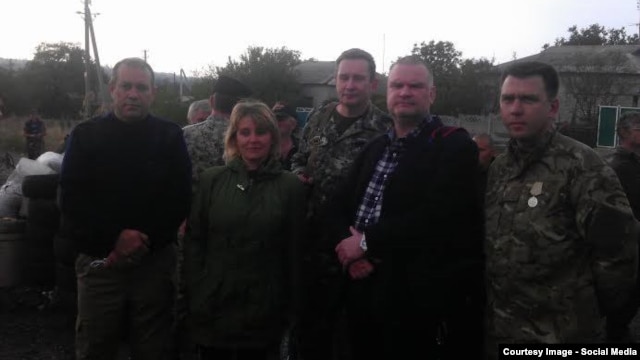
Natasha Rayakovich from the OSCE press office told Svoboda that
currently the mission is attempting to clarify where he came from.
Svoboda
reports that Graudins is a member of the Congress of Non-Citizens of
Latvia, the leftist anti-globalist party Demokrati.lv and is running in
elections this week in Latvia from the Russian Union of Latvia. He
served in the USSR armed forces and Latvia’s reconnaissance paratrooper
units as a senior officer of the defense ministry.
The representative for the issue of human trafficking at the Organization for Security and Cooperation in Europe (OSCE), Kazakhstan’s
Amb. Madina Jarbusynova, has used an appearance on Ukrainian TV to fuel a false claim by
the Russian state media of Ukrainian atrocities including “organ-trafficking”.
The claim was based on comments about a mass grave found outside of Donetsk from a pro-Russian Latvian activist
Einars Graudins who claimed to be an OSCE expert. He was subsequently disavowed by OSCE and the “organ-trafficking” story in fact discounted by the separatists’ prime
minister Aleksandr Zakharchenko himself who explained — after a day of sensational Russian state media reports — that he was referring to other graves of combatants who died from shrapnel wounds, accounting for the missing intestines.
reported, the Russian state and pro-Kremlin private media have been
making exaggerated claims related to a discover of a mass grave outside
of Donetsk with 9 victims, falsely claiming that it had “40” victims, based on a mis-reporting of Zakharchenko’s remarks, and
then “400” based on misleading statements from separatist leaders and a
pro-Russian Latvian activist. The Russian media has claimed there was
evidence of “organ-trafficking” made from the exhumation of the bodies — and first misleadingly cited a pro-Russian Latvian activist who had not actually been at the exhumation of the graves, then triumphantly cited a Ukrainian TV show as “proof” of “OSCE’s” claims.
Translation: Special representative Madina Jarbusynova on the work of OSCE in combatting human trafficking in Ukraine.
At 7:35, Amb. Jarbusynova says (translation by The Interpreter):
“Last week at the annual meeting on the implementation of obligations in the human rights field (OSCE HDIM), there was a statement from the mass media — not the mass media, but non-governmental groups working in this sphere about how allegedly, in the east of Ukraine, graves were found where, according to evidence, these bodies were found without their internal organs, so here the question is raised that there exists possibly trafficking in organs. At this meeting it was stated that observers from the OSCE mission will carefully investigate this information, that it should not be politicized. Facts are needed that confirm whether this took place.“
This story-telling is in keeping with a frequent technique of Russia (and for that matter, Kazakhstan) in first claiming some atrocity has occurred (if committed by Ukrainians) (or not occurred, if Russia is blamed) and then insisting that an international investigation is absolutely needed to clarify the story — even though the claim was concocted in the first place by disinformation specialists.
This was the case, for example, with Russian claims of the use of white phosphorous by Ukrainian army, for which no evidence was found, and which was the subject of Russian state media broadcasts with footage used from Syria, claimed falsely to be from Ukraine.
But the damage is already
done as numerous people on Twitter and blogs and Russian propaganda
sites begin to copy the organ-trafficking claim as “truth.”
Translation: Special representative of the OSCE on
combatting human trafficking Madina Jarbusynova stated that there is the
possibility that bodies discovered in mass graves in Donbass could be
without internal organs, which could have been sold. She stated this on
the 112 Ukraina television channel.
As we reported, the
story is based on remarks made by the “prime minister of the Donetsk
People’s Republic,” Aleksandr Zakharchenko, who noted in press
interviews that there could be “up to 40” persons in mass graves and
that their internal organs were removed. After this story had a day to
spread like wildfire, Zakharchenko walked it back,
explaining that the
figure of 40 was not regarding the 3 mass graves OSCE had found, and
that he was referring to other graves containing combatants both from
the pro-Russian side and Ukrainian armed forces. The organs were
missing because the people had died from shrapnel wounds — he himself
had not made any allegation of organ-trafficking:
“Every day
we find some sort of graves which remain after the Ukrainian army. The
bodies discovered without internal organs are marks of wounds. After
forensic analysis they may prove how they were damaged, that these are
shell wounds from the explosion of mines. The ones I spoke about
(earlier) — these are graves of my people and Ukrainian armed forces.”
The
propaganda campaign follows the pattern of other such operations by
Russian sources which first float a falsehood and cite a seeming
authority, then later provide further information even contradicting the
claim of the headline, in a follow-up story the same day or the next
day.
Japbursynova was notorious during the period of Kazakhstan’s
chairmanship of OSCE in 2010, where she threatened NGO leaders with
jailing for their criticism of the Kazakh government — which made good
on the threats — and accused Western NGOs who planned to hold an independent parallel human rights conference during the official OSCE summit in Astana as “terrorists.”
The Moscow Helsinki Group, one of the oldest human rights organizations in Russia, announced 1 October that it is forced to roll up most of its operations inside Russia due to funding issues, Moscow Times reported.
“We’ve cut projects to a bare minimum. You could say we’re simply surviving,” the organization’s chairwoman Lyudmila Alexeyeva said, Interfax reported.
The group has suspended its educational program, sacked 10 of 17 staffers and cut salaries for the rest, the 87-year-old activist said.
The cuts came despite a presidential grant of 4.5 million rubles ($115,000), which the organization has allocated to promoting public oversight of Russia’s often-criticized police force.
Alexeyeva blamed the cuts on decreased foreign-donor activity due to recent legislation.
The culprit is the “foreign agents’ law” which requires organizations that receive foreign grants to register as “foreign agents” and be subjected to more scrutiny. Back in 2012 when the law was passed, Alexeyeva said she refused to register her group.
Alexeyeva, arrested at a New Year’s Eve rally in 2010 protesting against restrictions on public assembly.
Alexeyeva has been vilified recently in the state media with false claims about her public positions.
A hostile NTV camera crew stalked Alexeyeva when
she met with businessman and philanthropist Dmitry Zemin
and former prime minister Mikhail Kasyanov (at 2:32) , who are accused in the video
of funding the March for Peace two weeks ago in Moscow which 26,000 protested the war in Ukraine.
The Moscow Group to Assist the Implementation of the Helsinki Accords, known for short as the Moscow Helsinki Group, was founded in May 1976, one year after the signing of the 1975 Helsinki Final Act on Security and Cooperation in Europe. It was among a few such groups at the time that took international law seriously and saw it as a tool to liberalize oppressive conditions in the Soviet bloc.
It was the first of such monitoring groups related to Helsinki and spawned a network of them all over the former Soviet Union and Eastern Europe and eventually the West, where Human Rights Watch, which began as Helsinki Watch, followed the model established by Dr. Yuri Orlov, a physicist, Alexeyeva, Elena Bonner, wife of Nobel Prize Laureate and physicist Dr. Andrei Sakharov and other scientists and intellectuals.
The group and its affiliates prepared hundreds of reports on everything from labor rights to religious freedom, which they placed in the Western press and foreign broadcasting programs at a time when such writings were suppressed in the USSR. Ultimately more than 50 of the members of these groups were jailed for sentences as long as 7 years of prison and 5 years of exile. Alexeyeva and several other members chose to emigrate to the US rather than face jail and continued their work from abroad for more than a decade.
Inside the Soviet Union, lower-profile dissidents persevered throughout the 1970s and 1980s, until the group suspended itself activities and announced a “dissolution” in 1984 when Bonner was arrested and exiled and the lawyer Sofya Kalistratova was threatened with arrest. They resumed in 1988 after some political prisoners were released such as biochemist Sergei Kovalev, and ultimately in the 1990s, Alexeyeva was able to return to Moscow to assume leadership of the group. The organization focused on prison conditions, freedom of speech and assembly, and legal aid to citizens and conditions in Russia’s regions, far worse than Moscow.
At one time, Putin even gave Alexeyeva, now 87, a bouquet of flowers on her birthday, and an official congratulatory message was published on her 85th birthday on kremlin.ru.
For a period in the 2000s, Alexeyeva was a member of the Presidential Council on Civil Society Development and Human Rights, but did not run for renewal of her office citing increasing cooptation of the human rights movement amid a worsening climate for human rights. She and her colleagues were begrudgingly tolerated for some years and even able to get meetings with top law-enforcement and political leaders to press their concerns. During the presidency of Dmitry Medvedev, the group members met in a televised meeting to discuss poor conditions in prisons and for labor migrants.
But recently, however, the human rights advocates began to be lumped together with political opposition like Alexey Navalny, although they were not members of opposition parties, and have been castigated as “fifth columnists.”
Alexeyeva has been a long-time outspoken critic of the Kremlin and is likely to remain so.
National Media Group is the owner of REN-TV, St. Petersburg’s Channel Five, Izvestiya, Russkaya Sluzhba Novosti (RSN), the radio station, and Channel 1.
NMG is a holding company that is a subsidiary of Rossiya Bank, whose chairman is Yuri Kovalchuk. Both Rossiya Bank and Kovalchuk himself are in the US sanctions list because of Russia’s war against Ukraine
Kabayaeva, a close associate of President Vladimir Putin even rumored to be his mistress, left her seat in the Duma to take the new job. In an interview with Channel 1, she said (translation by The Interpreter):
Media business is an unusual business. And here you have to think not only about profit but also about the interests of the entire society. That is, the interests of millions of people who watch, listen and read. And I hope my experience — I worked in the Civic Council and in the State Duma will help me in this work.
The media form our public. And a debate of sorts is always going on: what does the public need. I think for example that television doesn’t just educate but television imposes a lot on our public. And no one asks if that is what the public wants. There has to be a balance between the public and business. And that for me personally is very important. Therefore that is the direction that we will move in.”
It’s hard to know what this muddle of hortatory cliches really means, and whether state propaganda will become less crude or more; REN-TV is setting the tone, however, with a hysterical distortion of mass graves found last week outside of Donetsk, complete with the use of unrelated pictures and false statements from pro-Russian experts.
The BBC reported today that Russian state TV is using photos of MH17 victims in reports of “mass graves” of war dead outside of Donetsk.
The BBC found photos of body bags on the REN TV site from the MH17 Malaysian airliner believed to be shot down by Russian-backed separatists, to illustrate its stories on mass graves found outside of Donetsk. (See our Evidence Review: Who Shot Down MH17?)
The pictures BBC saw earlier today of body bags in rows on the ground were in fact from the MH17 scene. These appear to have been removed this afternoon, however and a photo of a dead woman has replaced them, which does not appear to be in Google image search except from another Czech site reporting on the same Russian story.
Says BBC:
REN TV is part of the National Media Group (NMG) controlled by Bank Rossiya, whose largest shareholder, Yuriy Kovalchuk, is said to be a close associate of President Vladimir Putin.
NMG was recently in the news when it was announced that the new chair of its board would be Alina Kabayeva, the former gymnast and MP who has been romantically linked to Putin.
As we reported yesterday, the Russian government has launched a hysterical campaign around the mass graves which were reported by monitors from the Organization for Security and Cooperation in Europe (OSCE) after separatist fighters brought them to the sites, a coal mine and another burial ground in Nizhnyaya Krynka, about 60 kilometers from Donetsk. Donetsk is still held by separatists despite the continued presence of the Ukrainian army at the Donetsk Airport.

RIA Novosti
REN-TV also launched a report today misleadingly claiming that a Latvian human rights activist who accompanied the OSCE observers’ team has confirmed the finding of “400 bodies in mass graves.”
One headline says “UN to Inspect Mass Graves in Ukraine,” and the anchor complains that international organizations remained “blind and deaf” to atrocities committed by the Ukrainian forces in the world — although in fact there has been plenty of Western media and international concern about these allegations.
Another story, REN TV says “400 Bodies Found in Mass Graves Outside Donetsk,” citing Einars Graudins, the Latvian activist.
But the actual quote from Einars Graudins says something different (translation by The Interpreter):
“At the present time, in the morgues of Donetsk alone there are 400 unidentified bodies. Obviously, their number will grow as the exhumations are conducted at the discovered graves.”
But that sound like Graudins is saying that in the morgues in general there are 400 bodies, not in the newly-discovered graves. REN-TV appears to have deliberately distorted the quote to create a sensational and re-tweetable headline.
RIA Novosti also ran a sensational headline “OSCE Expert: About 400 Bodies Found in Graves Outside Donetsk” but inside the the story, which quotes the Russian government’s newspaper of record, Rossiyskaya Gazeta, it states that unidentified bodies were in the morgues of Donetsk, quoting Graudins.
Graudins, who describes himself on Twitter as a theoretician of Marxism and an anti-globalist, is a political analyst, columnist and talk show guest with anti-American and pro-Russian views.
He is described in some accounts as “an OSCE expert” but it’s more tenuous than that: he was one of eight human rights experts from different countries who accompanied the regular OSCE monitors to visit the grave sites, according to rg.ru.
The original story in Rossiyskaya Gazeta (RG) from which other accounts were taken has the headline “Better to See One Time” and a statement at the top of the article that “more than 400 bodies of civilians and executed militia were discovered.”
But RG has the following quote from Graudins (translated by The Interpreter):
RG: Who is doing the exhumation?
EG: This is being done by officers of the DPR law-enforcement agencies: the Interior Ministry, prosecutor’s office and police. They are carefully documenting the extraction of each body, conducting forensic analysis and sending the body to the morgue.
At the present time, in the morgues of the city of Donetsk alone there are 400 unidentified bodies.
Obviously, their number will grow as the exhumations are conducted at the discovered graves.
Graudins admits that he didn’t actually stay on the site for the exhumation:
When we arrived there, the corpses were removed. We were told that the bodies were already in a severe stage of deterioration when they were discovered. In the grave at the village of Nizhnyaya Krynka only one grave has been dug up. There was an unbearable stench of corpses, which means that not all the bodies have been extracted from the ground. This grave was also in an open part of the area, looking a lot like a field. Everything was all plowed up there. Not far from it was a building destroyed by bombing.
We were offered to be present during the diggings. But we couldn’t because we were limited in time. It should also be understood that this is a difficult situation — Ukrainian snipers work in this zone.
Yet this area is under control of the separatists. And that’s the problem — this entire process of discovery and exhumation of graves has been left to the Russian-backed separatists — they replaced and control all the law-enforcement agencies of Donetsk — and it is not clear how much OSCE is present to monitor this entire process.
It’s also not clear whether the 400 bodies in the morgue were there already, or had come from mass graves just found which separatists claimed to contain civilians, or whether the deceased are fighters from both sides of the conflict — or possibly even Russian soldiers, whose bodies have also been rumored to be thrown down mines.

Reuters/Marko Djurica
Meanwhile Aleksandr Zakharchenko, prime minister of the self-declared “Donetsk People’s Republic” has walked back remarks he made yesterday, which were widely quoted by Russian state media to portray the numbers of victims in the graves as far higher, and which also served to spread the lurid rumor that there was organ-trafficking, a staple of Soviet-era propaganda now resurrected by the Kremlin in the current information war.
Zakharchenko says when he mentioned the bodies found without internal organs, he meant that these were separatist fighters and Ukrainian forces who died from shrapnel wounds.
Zakharchenko also said that new graves being discovered by the separatists contain their fellow fighters or Ukrainian soldiers.
These are not the graves of civilians as reported yesterday.
“Every day we find some sort of graves which remain after the Ukrainian army. The bodies discovered without internal organs are marks of wounds. After forensic analysis they may prove how they were damaged, that these are shell wounds from the explosion of mines. The ones I spoke about (earlier) — these are graves of my people and Ukrainian armed forces.”
He clarified that these graves are not related to the ones observed by the OSCE, which accounts for the discrepancy in numbers; he had estimated “about 40” but OSCE had reported on 9.
He emphasized that in speaking about “graves,” it is not always a question of the graves of civilians, which “inflamed the public and which OSCE is involved with,” which accounts for the conflicting information. The burials of soldiers, Zakharchenko added, are almost everywhere, near populated areas in the south-east of the country, “it’s just a question that these are not civilians, but military.”
“I am looking at the dimension of all these graves, and OSCE is looking at the dimension of the graves of civilian residents, therefore there is a discrepancy in the data,” said the prime minister.
The latest OSCE Special Monitoring Mission report does not contain any mention of these new claims of “400” so we will wait to see further reporting from OSCE.
Meanwhile, it seems that this is what is going on with these reports: a pro-Russian Latvian human rights activist among others in an OSCE mission, who has not actually monitored the exhumation process, has rushed to the Russian state press to tell a sensational story.
And even his words may have been further distorted, so it is not clear whether these bodies are all dead people in the morgue in Donetsk; all those found in newly-discovered mass graves; or whether they are combatants or civilians.
On September 29th, the American conservative outlet Breitbart published an article pointing out that according to the Government Accountability Institute (GAI), U.S. President Barack Obama only attended 42% of his daily intelligence briefings. GAI is a right-wing think tank, but while some fact checkers have taken issue with the report and while National Security Council spokesman Tommy Vietor downplays the issue, no one dispute the numbers.
Regardless of the issue at hand, Breitbart isn’t the only website interested in the report. The Russian state-operated propaganda outlet RT ran a story on the issue today. However, a close look at the two reports provides clear evidence that RT, perhaps more worried about making the US president look bad than following journalistic ethics, appears to have plagiarized the entire Breitbart article. Nearly every single paragraph is a direct paraphrase or rewording of the Breitbart piece, most of the paragraphs are structured the same way and are in the same order, both pieces use the exact same quotes and citations in exactly the same place, and except a few added paragraphs about Bush tacked on by RT at the end, there does not seem to be any substantial difference in the articles at all. And, to be clear, RT’s article was published after the Bretibart article.
Here are screenshots of the two articles side-by-side, the Breitbart article on the left and the RT article on the right. We’ve highlighted the similar paragraphs.
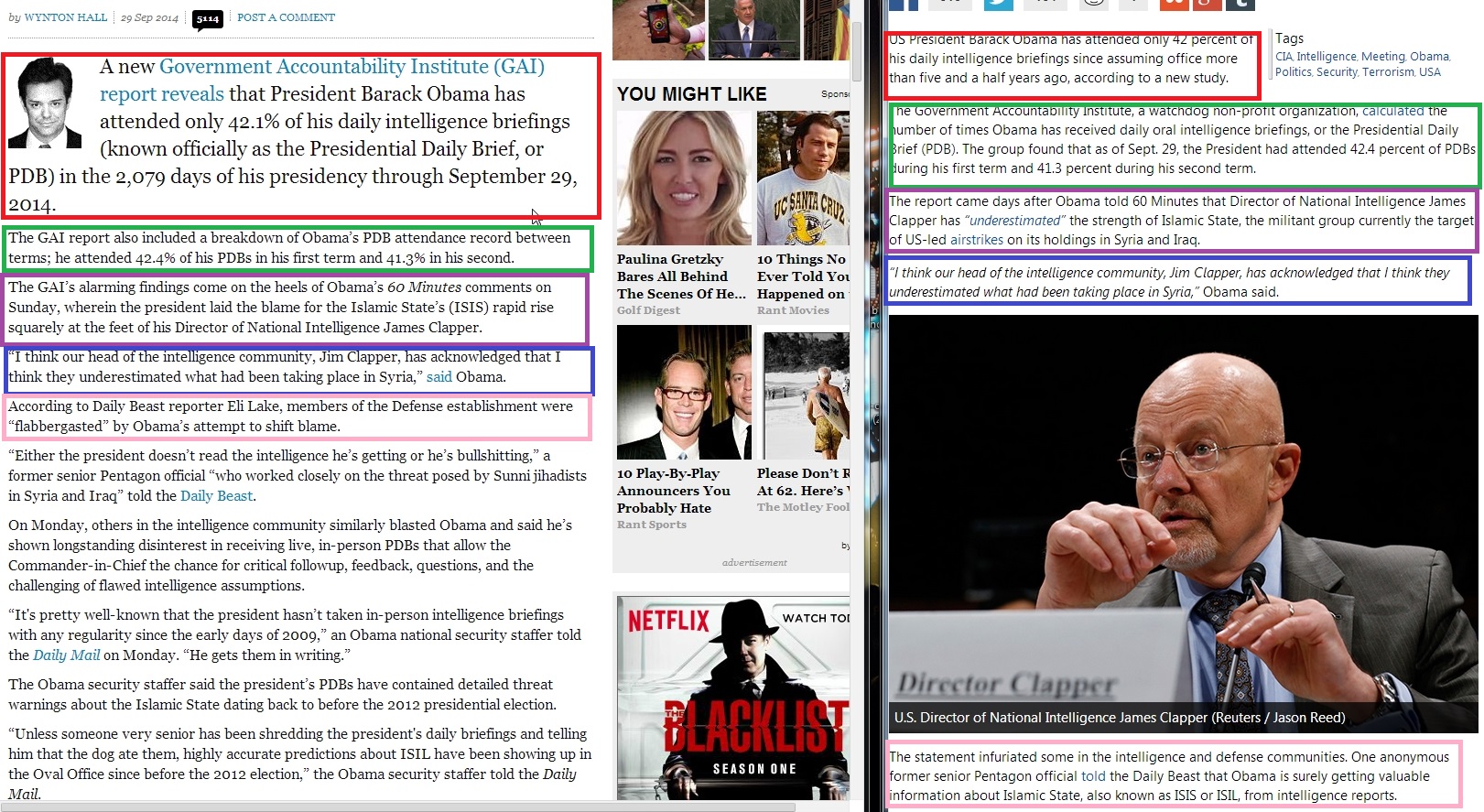
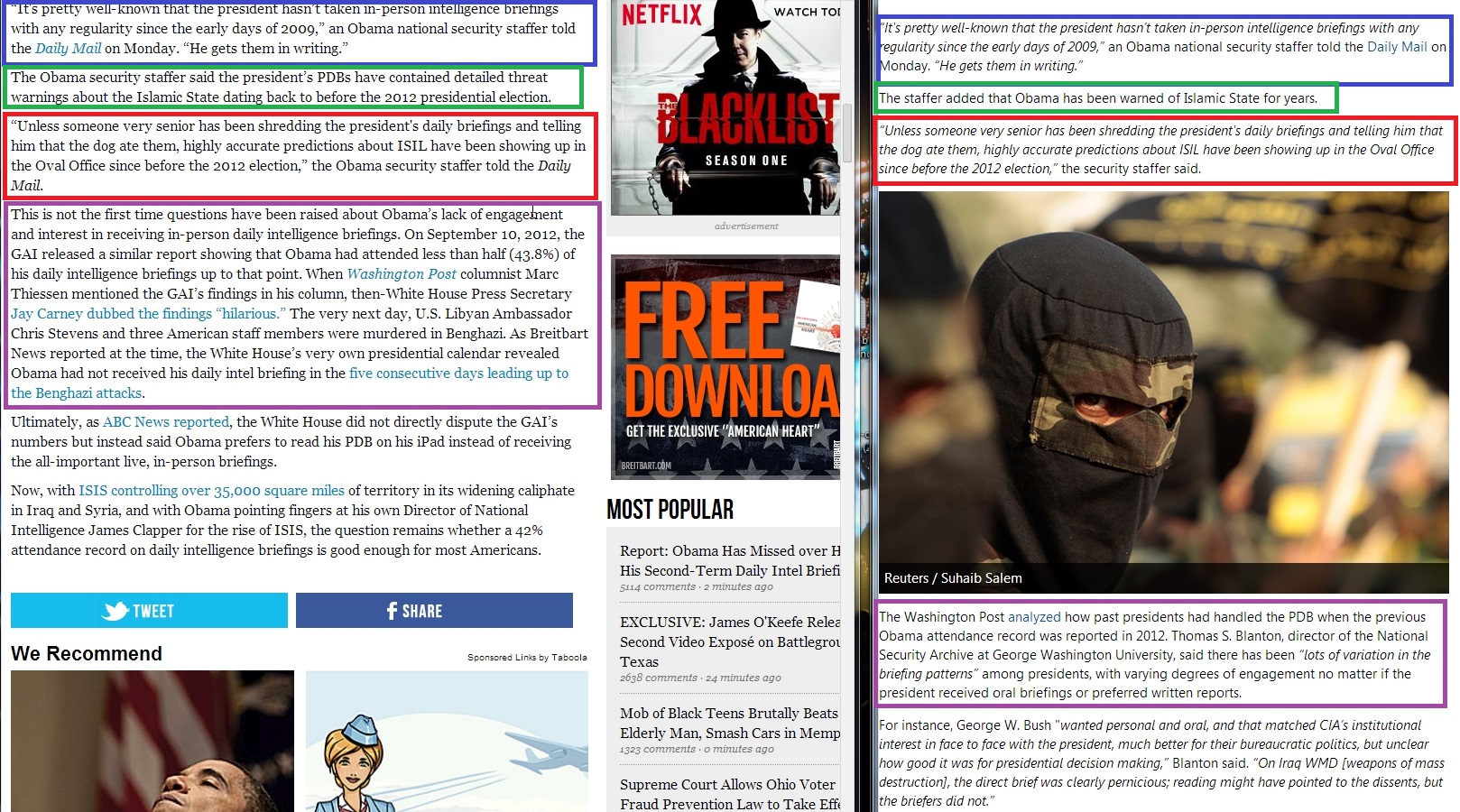
In fact, the only clear difference between the two is that RT inserts pictures which break up the paragraphs. Even the sections on the Breitbart story that we did not highlight above correspond to the rest of the paragraphs on the RT story, but because of RT’s picture of James Clapper, the paragraphs are not right next to each other in the screenshot.
Translation: the Russian ruble has fallen to a new record low. How to stop this fall? .0253 rubles per dollar
There are reports that Moscow is considering capital control measures, though Moscow is denying this. Nasdaq reports:
The Russian ruble hit a fresh record low against the central bank’s target basket of U.S. dollars and euros, slipping below the level at which the bank intervenes to support the currency, amid fears that Moscow may consider capital controls to stem the flow of money out of the country.
The ruble recovered slightly after the central bank and the Finance Ministry said they aren’t considering such restrictions. It had slid to more than 44.40 rubles to the basket after Bloomberg cited two unnamed Russian officials as saying the bank was considering temporary capital controls if capital outflows intensified.
The drop Tuesday underscores nervousness around the ruble, which has dropped nearly one-fifth against the U.S. dollar this year, battered by large capital outflows and an economy close to stagnation amid Western sanctions.
The ruble closed at 44.25 to the euro-dollar basket after briefly touching 44.52, crossing the threshold at which the central bank starts selling dollars and euros to smooth fluctuations. The ruble also hit an record of 39.89 against the dollar before recovering to 39.57 by the end of the day.
Russian officials were quick to deny the report of considering capital controls, which Russia scrapped in 2006. A Finance Ministry official, who asked not to be named, said the ministry would be against such a move, even if the government were considering it. Net outflows are forecast at $100 billion this year.
As we’ve been reporting since last week, one of the main causes for the sudden fall in the ruble is the confirmation of a lawsuit which will nationalize Bashneft, an oil company which is now a division of the Russian conglomerate Sistema (headed by Vladimir Yevtushenkov). Yevtushenkov, who reportedly has connections to the Ukrainian separatists, was put under house arrest, sparking fear among investors that Russia is once again trying to exert greater control over the energy sector and reminding some of the imprisonment of Mikhail Khodorkovsky more than ten years ago.
Yesterday Sistema’s stock plummeted, helping to push the Russian stock index MICEX down. ITAR-TASS reports:
The Sistema stock fell by 20.3% to 13.550 rubles ($0.34) per share compared with a 0.09% fall in the MICEX stock index and a 1.14% decline in the RTS stock index.
Sistema’s stock was falling by 7-10% in early Monday trading on the Moscow Stock Exchange on Monday and then accelerated its plunge in the afternoon to 15.6% to 14.350 rubles ($0.36) per share.
Bloomberg, however, notes that the struggling MICEX has more to do with the tumbling ruble than with stock selloffs:
While the RTS gauge, which is quoted in dollars, is down 21 percent from a six-month high reached June 24, the benchmark Micex Index (INDEXCF), which is denominated in rubles, has only lost 7.3 percent over that time. The ruble’s performance in the past three months — a 14 percent tumble that’s the biggest decline among all currencies tracked by Bloomberg — accounts for the difference.
“The plunge in the ruble is affecting the RTS, and it looks like there will be further pressure on the currency,” Kirill Yankovsky, director of equity sales at Otkritie Capital, said by phone from London yesterday. “The RTS index hasn’t had an opportunity to leave the bear market for most of this year, it was down with just a few rebounds, and there is little incentive for the index to go up.”
The RTS has plunged since June as international sanctions against Russia for its involvement in the Ukrainian conflict prompted investors to pull money out of an economy that’s on the brink of recession. The gauge completed its first 20 percent drop that commonly defines a bear market in March as President Vladimir Putin annexed the Crimean peninsula. It then rebounded in May as the central bank intervened to strengthen the ruble and tension in eastern Ukraine eased.
Today the MICEX is actually up, but only by .2%, following a substantial day of losses.
The bottom line — after months of tensions and increasingly costly sanctions, new worries are deterring investors and weakening the value of Russia’s currency. Since the economic outlook for Russia before all of these events was not terribly promising, without new and better news for investors there is no indication that either the ruble or Russia’s markets are likely to rally any time soon.
Andrei Stenin, a RIA Novosti photographer, was found dead in eastern
Ukraine, near Snezhnoye (known in Ukrainian as Snizhne), in late August.
But the conditions under which he died are still a mystery, and as The Interpreter’s
in-depth investigation into the case reveals, there are more questions
than answers regarding the case. The Russian-state media appears to have
been engaged in a series of denials and cover ups, changing details,
deleting tweets and entire stories, and hiding important details — like
the fact that Stenin was not killed alone but two other bodies were
found with him.
In fact, there are dark whispers about the two Russian journalists,
Dmitry Steshin and Aleksandr Kots, who found the bodies of three
people, including Stenin, and reported them to the OSCE. Were Russian
journalists working with separatists leaders like Colonel Igor Strelkov
to create a narrative that Ukraine was guilty of war crimes? What is the
connection to these journalists and Russian ultra-nationalists? And did
these journalists, including Stenin who was killed, know exactly who
shot down MH17?
Read our entire investigation here: Andrei Stenin and His Fellow Travelers: How Russian State Media Help Fight the War Against Ukraine
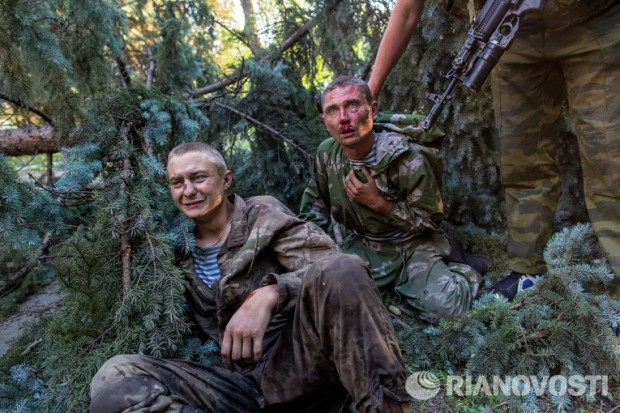 Andrei Panasyuk and another Ukrainian POW. Photo by Andrei Stenin/RIA Novosti
Andrei Panasyuk and another Ukrainian POW. Photo by Andrei Stenin/RIA Novosti
Pro-government groups staged a mass rally on Saturday, 27 September at the war memorial in Moscow called Poklonnaya Gora. The action was titled “Donetsk: Innocents Murdered,” and was part of a Kremlin-orchestrated campaign to accuse Ukraine of war atrocities, distracting from its own role in backing separatists who themselves have widely committed numerous such crimes.
The organizers originally had obtained a permit for 5,000 people, but 17,000 were claimed by state media to take part. Independent press said about 6,000-8,000 in fact were present. Despite reports that the mayor’s office threatened fines, Novaya Gazeta confirmed that the head of the Moscow department for regional safety said they would not be fined as there had been no danger.
Pro-government demonstrators spelled out the word “Donbass” with candles, mimicking a widely-photographed action by anti-government peace activists last month who had spelled out the total number of victims in the war in another action.

Demonstrators at an authorized rally on 27 September spelled out the word “Donbass” in Russian with candles. The sign says “Fascism is Evil.”
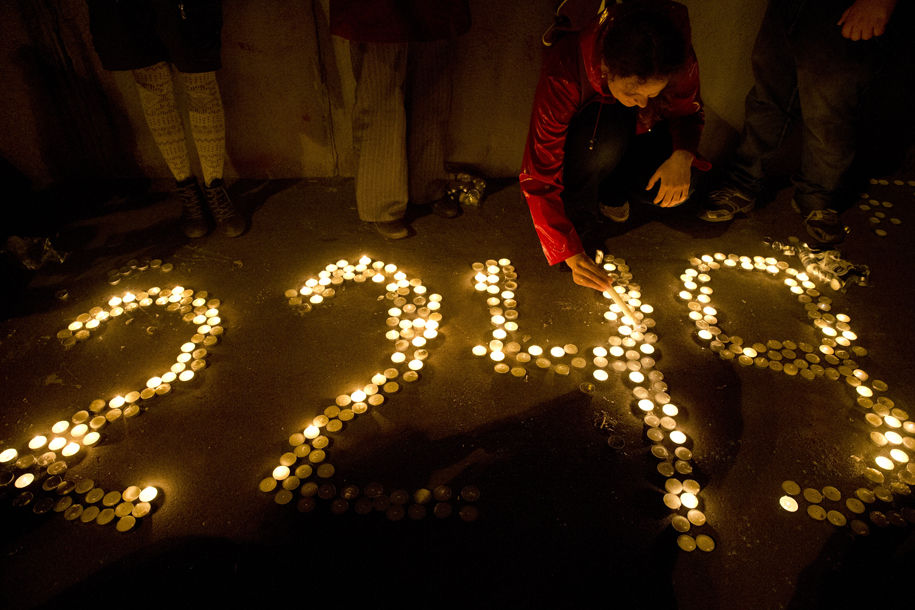
Peace activists at an unauthorized rally on 31 August spelled out the number of persons killed in Ukraine at that time; today the number is over 3,000. Some were arrested for the unauthorized action.
Participants in the Poklonnaya Gora action, most of whom wore St. George ribbons and carnations, included Just Russia, Zhirinovsky’s ill-named Liberal Democratic Party of Russia, Right Cause, the Motherland Party, the Parents’ Association, Union of Machinists of Russia and people with the “people’s republics” and “Novorossiya” flags. Buses were organized to bring them to the event.
Refugee children from Ukraine were brought on stage to read poetry, along with Afghan veterans and Aleksandr Prokhanov, the ultranationalist and frequent state television guest, who intoned about the “monster of fascism born on Maidan.”
Critical coverage by Sotnik TV, an independent YouTube program run by Sasha Sotnik was slammed by Kremlin propagandist Konstantin Rykov, who said it was a “vivid example of liberal lies” — grabbing traffic with it to his own blog. He posted his own report of how the rally “really” was, but it showed only silent scenes of people lighting candles.
Sotnik’s episode
in fact contains interviews with participants of the rally where, in
their own words, they created a picture of a public brainwashed by
Kremlin propaganda.
Most said they believed what was on Russian state TV, and were indignant about what they had heard regarding alleged atrocities; they chorused the motif that the Kremlin has pushed all along with its war on Ukraine, that the Kiev government is “fascist” and must be fought just as the Soviets fought the Nazis. One woman made a point of saying she was educated, with a Ph.D, and could not be fooled, yet she believed America was responsible for waging war on Russia by unleashing events in Ukraine.
People interviewed said they came of their own volition, but Russian bloggers found evidence that they were part of what is known as the biznes-massovka (known as “rent-a-crowds” in the Soviet era), people paid to turn out for large events like extras on a movie set.
One LiveJournal blogger spotted an ad which we verified on massovka.ru, where people are recruited for everything from movies to state holidays. The ad, headlined “27 September Action of Grief, Memorial for Victims of Donpass, Payment 300 Rubles” offered the equivalent of about $7.70 to those who came to the Poklonnaya Gora event. As round-trip metro fare would only be 80 rubles (about $2), the payment would not be just for car fare.

The blogger also caught sight of a line of people waiting to receive pay packets right after the demonstration.
Translation: Money honestly earned for grieving was handed out at 21:00 in a courtyard next to Poklonnaya Gora. LiveJournal blog viking-nord.
Novaya Gazeta also found some people who said they were told to attend by superiors at work.
Moscow
liberals believed that the rally was staged as a counter-event to their
own March for Peace on 21 September, which drew 26,000 people.
Participants denied that was their goal in interviews with gazeta.ru
Kremlin
propagandists went to every effort to confuse and distort the March for Peace two weeks ago, repeatedly claiming that it was banned or cancelled when in
fact organizers were given a permit, then denouncing the participants as
“traitors” and “fifth columnists.”
The
theme of this weekend’s rally at the war memorial suggests that a
discovery of mass graves near Donetsk, heavily covered by Russia state
media but with distortions, likely fueled the turn-out as part of the
overall plan to portray the Kiev government as “fascists,” like those
who invaded Russia from the West in past wars.
In their coverage
of the Donetsk mass graves, the Russian media both exaggerated the
findings and left out a statement from separatist leader Aleksandr
Zakharchenko that the graves could contain Ukrainian soldiers as well as
POWs and civilian victims. The mass burials of 9 people were found by
separatists themselves in area now under their control, which they claim
was previously under Ukrainian control.
Amnesty
International has documented at least three cases and others suspected of
kidnappings and torture committed by Aidar, a Ukrainian battalion, although not murders, by contrast with
killings by separatists. The Russian government continues to claim
without justification that Russian state journalists embedded with
separatist fighters were deliberately targeted by Ukrainian forces.
Russia
has called for an international investigation, claiming that Kiev has
reneged on its pledge to investigate sniper deaths, the Odessa fire, and
other mass deaths.
Yet the Russians have manipulated public perceptions
on these stories, for example in claiming falsely that an intercepted phone
call with the Estonian Foreign Minister and a Ukrainian physician cast
blame on the Maidan demonstrators themselves for the sniper shootings, when
in fact nothing of the kind was said — the Foreign Minister was in fact
recounting the Moscow propaganda version of the story in the call. Ukrainian authorities have found the Berkut riot police responsible for the deaths, and raised the issue of Russian involvement.
Meanwhile, Kremlin propaganda outlets like Russia Behind the Headlines, reprinted by the British Telegraph and Global Research continue to flog the false claims of a Ukrainian parliamentarian that Berkut was not behind the shootings whereas Ukrainian investigators have identified the shooters and Western journalists such as the Daily Beast have found evidence of Russian involvement in the sniping deaths.
And
Russia doesn’t like the international investigations that have already
taken place — the UN High Commissioner for Human Rights has found 812
kidnappings committed by the Russian-backed separatist fighters in the Donbass, many of persons who have disappeared, Human Rights Watch has also documented such abuses; and the Dutch Safety Board have found the MH17 to have
been shot down by a surface-to-air-missile, not a Ukrainian airplane as
Russia claimed.
The Victory Park of Poklonnaya Gora (literally
“Prostration Hill”) was originally built in the Soviet era as an
open-air museum dedicated to Russia’s victory over Napoleon at the
Battle of Borodino — a theme that has also been central to Russian-supplied separatists.
Then in 1995, under Yeltsin, a statue of St. George
slaying the dragon and an obelisk were added as well as an Orthodox
church and a Holocaust memorial synagogue with a statue of Holocaust
victims. Putin then began to hold V-Day celebrations at this site in
2005, adding more columns devoted to the Red Army, and this year, a
memorial to World War I.
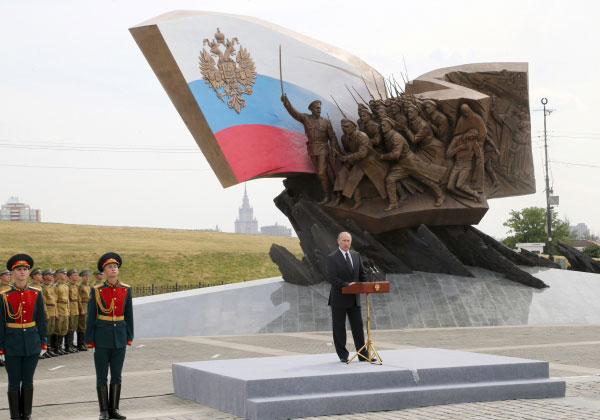
Mass graves found outside of Donetsk by Russian-backed separatists of the self-proclaimed “Donetsk People’s Republic” last week have provided an occasion for the Russian government to accuse the Ukrainian government of war atrocities.
This weekend a mass rally was staged in Moscow on this theme titled “Donetsk: Innocents Murdered” at the World War II monument Poklonnaya Gora. Today Russia’s Investigative Committee announced an investigation into “genocide” of Russians in southeastern Ukraine, BBC Russia’s Service reported.
On 24 September, ITAR-TASS ran a news article titled “Russian Foreign Ministry Believes Mass Graves Outside Donetsk Were at the Hands of Ukrainian Forces” (excerpt translated by The Interpreter)
Speaking at a session of the UN Commission on Human Rights, Amb. Aleksey Borodavkin, Russia’s envoy to Geneva, claimed that graves discovered near Donetsk contained “bodies of executed civilians on the territory of Donetsk region which was controlled by the Ukrainian forces. This war crime appears to be precisely at their hand. We will closely follow the assurances of the Ukrainian leadership about the investigation of all these rights violations.”
Borodavkin said that bodies found at the Kommunar Coal Mine No. 22 were determined by forensics experts to be killed by a shot to the head.
ITAR-TASS said the Russian ambassador claimed the territory was under the control of Ukrainian forces and the Aidar Battalion of the National Guard.
The claims appear to involve distortions of a review of the scene of the mass graves by OSCE’s Special Monitoring Mission in Ukraine, and even an admission by Aleksandr Zakharchekno, prime minister of the self-proclaimed “Donetsk People’s Republic,” that some of the victims are Ukrainian soldiers.
The report by the OSCE Special Monitoring Mission dated 24 September in fact stated the following:
The ‘military police’ of ‘Donetsk People’s Republic’ (‘DPR’) told the SMM that three unmarked graves allegedly containing multiple bodies had been found; two of them were located in a coal mine Komunar near the village Nyzhnia Krynka (35km north-east of Donetsk) and one inside the village. The SMM proceeded to the scene and saw in the coal mine two areas located fifty metres apart, each containing two human bodies. All four corpses were in the process of decomposition. The SMM also saw eight 9mm Makarov pistol cartridges approximately five meters away from the bodies. Near the road on the edge of the village, the SMM observed a pile of earth resembling a grave which had a stick with a plaque, written in Russian and containing the names (or in one case – initials) of five individuals. The plaque indicated that the individuals died on 27.08.2014. On top of the plaque there was another inscription saying: ‘Died for Putin’s lies’. Neither in the coal mine nor in the village did the SMM see any forensic experts. COMMENT: The SMM cannot provide a forensic assessment of the sites.
The Russian state media has failed to explain when and by whom the forensic examination was done; OSCE notes that they neither performed one themselves (which is not in their mandate) nor did they see any at the time. The Russian version also kept out mention of the sign on the grave or the exact total of victims.
Meanwhile, Russia media have run a number of stories citing separatists’ claims of “about 40 bodies found” in the graves in Nizhnyaya Krynka (known as Nyzhnia Kyrnka in Ukrainian), although the OSCE report indicates a total of 9 were found. As Moskovsky Komsomolets reported:
“Three graves have been found, in one of there are the bodies of civilians, they discovered about 40 there, and in two others, the bodies of militia POWs and Ukrainian soldiers,” Aleksandr Zakharchenko, prime minister of the self-proclaimed DPR, noting that this territory was under the control of Ukrainian forces for a long time.
RIA Novosti reported on September 25 that Zakharchenko told Russkaya Sluzhba Novosti which originally covered his remarks, “the exact number of mass graves are not known” in three mass graves although he estimated about 40. He said some of the bodies were found without their internal organs.
The Foreign Ministry announced last week that they will attempt to involve the UN, Council of Europe, OSCE and human rights organizations in the investigation of the Donetsk graves. Russian human rights commissioner Konstantin Dolgov also claimed that the territory was under control of the National Guard, which he said pointed to the perpetrators. Dolgov accused the West of “double standards” in seeming to ignore Ukrainian atrocities, although the allegations against Aidar involving documentation of 3 cases have been covered by in detail by Amnesty International and Western journalists.
The Russian campaign against alleged Ukrainian atrocities may be an effort to distract from other mass graves of 14 victims of Russian-backed separatists found in Slavyansk, some said to be executed on orders of Col. Igor Strelkov, including four Protestant church members who were kidnapped and murdered. The UN High Commissioner for Human Rights documented 812 kidnappings by separatists, some of whom were missing, in a July report.
